Collection of materials relating to neuro-ophthalmology as part of the Neuro-Ophthalmology Virtual Education Library.
NOVEL: https://novel.utah.edu/
TO
- NOVEL992
Filters: Collection: "ehsl_novel_novel"
| Title | Creator | Description | Subject | ||
|---|---|---|---|---|---|
| 1 |
 | Nonspecific Orbital Inflamation | Nonspecific orbital inflammation (NSOI), also known as idiopathic orbital inflammation or orbital pseudotumor, is a chronic, inflammatory condition that affects the orbit and the surrounding structures. It can mimic other disease processes such as malignancy or infection and should thus be worked up... | Idiopathic Orbital Inflammation; IOI; Nonspecific Orbital Inflammation; NSOI; Orbital Pseudotumor | |
| 2 |
 | Oculomotor Twist: Aberrant Regeneration of the Oculomotor Nerve Following Coil Embolization of a Carotid Cavernous Fistula | Naira Ikram; Nurhan Torun; Linda R. Dagi; Vivian Paraskevi Douglas; Konstantinos Douglas | We describe a case of a patient with an acquired third nerve palsy and discuss potential etiologies contributing to aberrant regeneration. | Aberrant Regeneration; Carotid Cavernous Fistula Embolization; Third Nerve Palsy |
| 3 |
 | Neuro-ophthalmology Presentations of Ocular Neoplasms | Annah Baykal; James O'Brien; Brian Firestone | Two rare cases of ocular neoplasms mimicking neuro-ophthalmic disorders highlight the importance of maintaining a broad differential diagnosis. In the first case, a 49-year-old female patient presented with unilateral decreased color vision/color desaturation and discomfort along with other visual s... | Neuro-ophthalmology Mimickers; Ocular Neoplasm; Optic Neuritis |
| 4 |
 | Dorsal Midbrain Syndrome | John R. Mark; Nandini Gandhi; Yin Allison Liu | In this module we discuss a patient presentation demonstrating dorsal midbraine syndrome (AKA Parinaud syndrome). Its purpose is to aid in teaching fellow providers how to recognize the clinical findings of dorsal midbrain syndrome by reviewing the relevant anatomy, exploring the etiologies of its p... | Collier Sign; Convergence-retraction Nystagmoid Movement; Dorsal Midbrain Syndrome; Light-near Dissociation; Parinaud Syndrome; Skew Deviation; Supraduction Palsy; Upgaze Restriction |
| 5 |
 | Evidence-Based Medicine in Neuro-Ophthalmology | Samuel Kim; Zubin Mathew; Sean Gratton | This is a narrated powerpoint that reviews the history and basic tenets of evidence-based medicine. Some basic neuro-ophthalmology clinical topics are reviewed as is compassion in evidence-based medicine. | Compassion; Evidence Appraisal; Evidence-based Medicine |
| 6 |
 | Foveal Displacement Diplopia Syndrome | This is a brief narrated powerpoint about the clinic entity Foveal Displacement Diplopia Syndrome, also know as Dragged Fovea Diplopia Syndrome. The presenter discusses the causes, clinical manifestations, and management. | Central Fusion; Diplopia; Dragged Fovea Diplopia Syndrome; Foveal Displacement Diplopia Syndrome; Peripheral Fusion | |
| 7 |
 | Orbital Fractures and Extraocular Muscle Entrapment | Christopher D. Yang; John Abdelmalek; Lilangi S. Ediriwickrema | Orbital Fractures and Extraocular Muscle Entrapment - NOVEL Chapters BKb-VI/VIII. This is a narrative review of the clinical anatomy and pathophysiology of orbital fractures as well as their diagnostic classification, management. The pathogenesis and management of the oculocardiac reflex and orbital... | Extraocular Muscle Entrapment; Oculocardiac Reflex; Orbital Compartment Syndrome; Orbital Fracture |
| 8 |
 | IgG4 Pachymeningitis: Case Report and Review of IgG4 | Joshua Pasol | 59-year-old man presenting with a left 6th nerve palsy. Neuro-imaging revealed thickened meninges, pituitary stalk, and skull base foramina. Work up revealed high IgG4 levels in the diagnostic criteria level for IgG 4 related disease. Treatment included oral steroids, rituxan and later mycophenolate... | Double Vision; IgG4 Disease; Pachymeningitis |
| 9 |
 | Late Onset Chiasmal Neuritis in Newly Diagnosed Neuro-myelitis Optica | Joshua Pasol | A 70-year-old African American woman presented with loss of vision in both eyes. She noted cloudiness in both eyes with mild headache and possible flu-like symptoms of body fatigue. The past medical history was of hypothyroidism on levothyroxine. Initial visual acuities were 20/250 in both eyes with... | Chiasmal Neuritis; Chiasmal Neuritis; euromyelitis Optica; euromyelitis Optica |
| 10 |
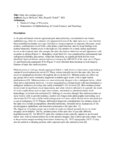 | Optic Disc Melanocytoma | Lucas McGuire; Ryan D. Walsh | A case of a 58 year-old-female with optic disc melanocytoma. A brief review of the condition is provided, and optic disc photography, optical coherence tomography (OCT), and fluorescein angiography (FA) findings relevant to optic disc melanocytoma are reviewed. | Melanocytoma; Optic Disc Melanocytoma; Optic Nerve Lesion; Optic Nerve Melanocytoma; Optic Nerve Tumor; Pigmented Optic Nerve Lesion |
| 11 |
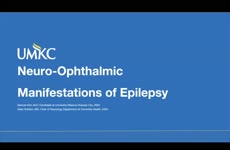 | Neuro-Ophthalmic Manifestations of Epilepsy | Samuel Kim; Sean Gratton | This is a narrated powerpoint reviewing important ways in which epilepsy and seizures can manifest with ocular symptoms. This includes gaze deviation, epileptic nystagmus, todd's paralysis. Vigabatrin toxicity is also reviewed. | Epilepsy; Epilepsy Syndromes; Epileptic Nystagmus; Gaze Deviation; Seizures |
| 12 |
 | Radiation Retinopathy | Precious S. Plaisime; Sean Gratton | This is a narrated powerpoint that reviews the basics of Radiation Retinopathy. Demographics and risk factors are reviewed. Pathophysiology, Clinical Presentation, Diagnosis, and Treatment are also discussed. | Ocular Melanoma; Radiation Retinopathy; Retinal Neovascularization |
| 13 |
 | Hydroxychloroquine Maculopathy | Rohit Balaji; Ryan D. Walsh | This case demonstrates the typical fundus, spectral domain optical coherence tomography, and visual field findings of advanced hydroxychloroquine maculopathy. The patient described in this case was treated with hydroxychloroquine for systemic lupus erythematosus for more than 20 years and presented ... | Bull's-eye; Flying-saucer; Fundus; Hydroxychloroquine; Maculopathy; Optical-coherence-tomography; Parafoveal; Plaquenil; RPE; Systemic-lupus-erythematosus; Visual-field |
| 14 |
 | Coughing It Up to Giant Cell Arteritis | Ethan Zerpa; Stacy V Smith | 71-year-old with cough, acute monocular diplopia, and bilateral blurred vision lasting eight days. ESR >130 mm/hr. FDG-PET with increased radiotracer activity in the thoracic aorta and branches with hyperintensity extending into the vessels of the neck consistent with giant cell arteritis (GCA). GCA... | Cough; Giant Cell Arteritis; Large Vessel Vasculities |
| 15 |
 | Screening Battery for Higher Order Visual Dysfunction Due to Neurodegenerative Disease | Victoria Pelak | Awareness that neurodegenerative disease (NDD) can cause visual brain dysfunction is critical for early detection and proper diagnosis. However, awareness must be combined with knowledge about visual brain pathways and clinical assessment tools that can be used to identify cerebral visual dysfunctio... | Alzheimer's Disease; Dementia with Lewy Bodies; Eye Clinic Rapid Screening Battery For Visual Cortical Dysfunction; Posterior Cortical Atrophy; Visual Cortical Dysfunction |
| 16 |
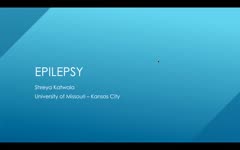 | Epilepsy Review | Shreya Katwala; Sean Gratton | This submission is a narrated powerpoint review of Epilepsy. It reviews the definition and diagnostic criteria of epilepsy. Common etiologies and types of epilepsy are reviewed. Basic epilepsy managment is also reviewed. | Epilepsy; Focal Epilepsy; Generalized Epilepsy; Provoked Seizures; Seizures |
| 17 |
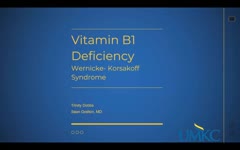 | Wernicke-Korsakoff Syndrome: Vitamin B1 Deficiency | Trinity Dobbs; Sean Gratton | This is a narrated powerpoint presentation about the neurological and neuro-ophthalmic presentations of thiamine deficiency. The clinical manifestations are reviewed. Basic biochemistry is briefly discussed. Management and diagnosis are explored. | B1; Korsakoff; Nystagmus; Thiamine; Wernicke |
| 18 |
 | A Suspected Case of Wildervanck Syndrome | Hari R. Anandarajah; Tejaswini K. Deshmukh; Ryan D. Walsh | A 5-year-old male with congenital right-sided hearing loss presented to the neuro-ophthalmology clinic for strabismus evaluation. He had longstanding bilateral abduction deficits with associated esotropia, for which he underwent bilateral medial rectus recessions at age three. He had persistent limi... | Cervico-oculo-acoustic Syndrome; Congenital Deafness; Duane Syndrome; Klippel-Feil Cervical Anomaly; Wildervanck Syndrome |
| 19 |
 | Chronic Migraine | Olivia Liu; Sean Gratton | This narrated powerpoint is a review of Chronic Migraine. This includes a review of the pathophysiology of migraine and what contributes to the chronicity of migraine. Treatments of chronic migraine are also reviewed. | Central Sensitization; Chronic Migraine; Migraine |
| 20 |
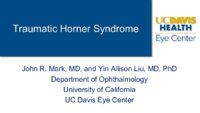 | Traumatic Horner Syndrome | John Robert Mark; Yin Allison Liu | This presentation is a discussion about the presentation of traumatic Horner syndrome (AKA "Oculosympathoparesis") and the emergent next steps that should be taken. The discussion highlights the varying presentations and gives an example of a patient who suffered an injury to the neck resulting in a... | Horner Syndrome; Horners; ICA Dissection; Internal Carotid Artery Dissection; Miosis, Oculosympathetic Paresis; Oculosympathoparesis; Preganglionic; Ptosis; Pupillary Pathology; Second-order Injury; Traumatic Horner Syndrome |
| 21 |
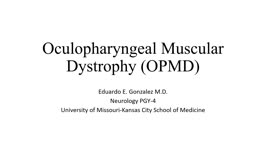 | Oculopharyngeal Muscular Dystrophy (OPMD) | Eduardo Gonzalez; Sean Gratton | This is a brief review of Oculopharyngeal Muscular Dystrophy. It includes a review of the background, pathophysiology, epidemiology, diagnosis, and management of the disorder. The key clinical features including ptosis and dysphagia are reviewed in detail. | Chronic Progressive External Ophthalmoplegia; Dysphagia; Muscular Dystrophy; Myasthenia Gravis; Oculopharyngeal Muscular Dystrophy; Ptosis |
| 22 |
 | Aqueous and Vitreous Humor | Ryung San Lee; Amanda Dean Henderson | Multiple choice test set administered to test comprehension of "Aqueous and vitreous humor" sub-section of NANOS Illustrated Curriculum for Neuro-Ophthalmology. The topics in this submission cover questions related to anatomical and physiologic concepts in aqueous and vitreous humor. More specifical... | Anatomy; Aqueous Humor; Vitreous Humor |
| 23 |
 | Myelin Oligodendrocyte Glycoprotein Antibody Associated Disease (MOGAD) Revisited | Zahir Sheikh; Michael Gilhooley | The purpose of this presentation is to review the varied clinical manifestations of MOGAD for the neurology and neuro-ophthalmology providers. | Demyelinating; MOG; MOGAD; Myelin |
| 24 |
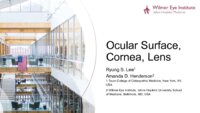 | Ocular Surface, Cornea, Lens | Ryung San Lee; Amanda Dean Henderson | Multiple choice questions set from the NANOS Illustrated Curriculum for Neuro-Ophthalmology. This question set is meant to accompany the video lecture on the anatomy of the ocular surface, cornea, and lens. The ocular surface is a complex topic and pertinent to the comprehensive ophthalmic care prov... | Cornea; Ocular Surface; Uvea |
| 25 |
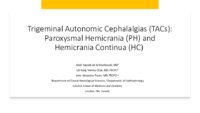 | Trigeminal autonomic cephalalgias (TACs): Paroxysmal hemicrania (PH) and hemicrania continua (HC) | Jihad Yaqoob Ali Al Kharbooshi; Tommy Lik Hang Chan; J. Alexander Fraser | In this narrated slideshow, we describe the pathophysiology, epidemiology, diagnostic criteria, subtypes, workup, and management of hemicrania continua (HC) and paroxysmal hemicrania (PH). | Hemicrania Continua; Paroxysmal Hemicrania; TAC, Trigeminal Autonomic Cephalalgia |
